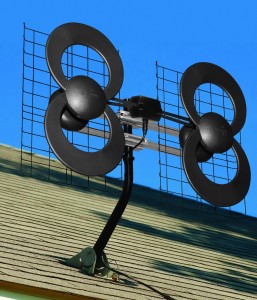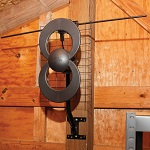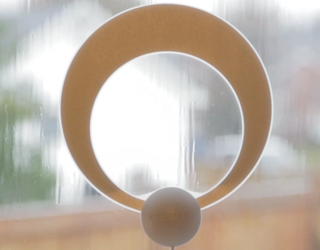Are you looking for an easy solution to cut the cord and say good-bye to monthly cable bills? Perhaps you are interested in adding a TV to a second location and you can’t stomach feeding the cable monster more dollars. A TV antenna is the quick and easy solution to FREE TV, but which antenna is right for you? Here we explore the benefits of both indoor and outdoor TV antennas.
Indoor TV Antennas
An indoor TV antenna may be the best solution if you live near the TV broadcast towers. They are also an excellent solution for people living in cities or apartments where mounting an outdoor antenna is simply not an option. They are small, powerful, and can be discreetly placed in any room.
Traditional dipole indoor antennas – or rabbit ears – don’t quite cut it today as they are tuned for VHF stations, while the majority of signals are now transmitted by UHF.
When installing an indoor antenna there will be building materials – brick, wood, stucco, or metal – impeding or interfering with your digital signal. Even household appliances – fridges, computers, and phones – can affect your signal. To overcome the signal loss, we recommend repositioning the antenna in a number of locations within the room – preferably near a window facing the direction of your local broadcast towers – to find the best position for a strong clear signal.
Recommended: ClearStream Eclipse Indoor TV Antenna
Outdoor TV Antennas
Where installation is possible, an outdoor TV antenna will offer the best opportunity for receiving TV signals. Outdoor TV antennas are traditionally mounted on a rooftop and have a better line of site to the broadcast towers, with fewer obstructions – trees, buildings, walls, or roofing materials – and they have a distinct advantage over indoor and attic antennas.
If you live a far distance from the broadcast towers, a long
range outdoor antenna is the best option for receiving the available signals. Outdoor antennas can also be mounted onto the sides of one’s house, decks, or on a tripod from the ground if roof access is not available. Remember, test your antennas position by scanning for the available channels before drilling any holes!
If you are having difficulty with your set-up, ask your neighbors if they too experience problems receiving channels. If they have similar issues with a particular channel then reach out to us here in the office and we will raise the issue with the local broadcaster.
Recommended: ClearStream 2V Indoor/Outdoor TV Antenna
Attic TV Antennas
For best performance, we typically recommend the placement of your TV antenna at the highest point possible and with a clear line of site to the broadcast towers. Of course, many people still  choose to install their TV antenna in the attic for aesthetic reasons or to comply with neighborhood guidelines.
choose to install their TV antenna in the attic for aesthetic reasons or to comply with neighborhood guidelines.
Keep in mind it’s possible to lose some signal strength from an attic installation due to building materials. With an attic installation, the effective range of most antennas is lowered by 30% to 50% (10-15 miles), so consider getting a more powerful antenna or a preamp to compensate for this loss. Additionally, it is always preferable to mount the antenna to a mast or crossbeam and avoid letting the antenna touch the floor.
Recommended: ClearStream 4 Outdoor TV Antenna
Be sure to visit antennapoint.com to locate your local broadcast towers serving your area. This will help you determine where your towers are located and which way to aim your antenna. If you are not sure which TV antenna is right for you, we have a dedicated team of installation experts that will gladly assist with your antenna selection.
Call: 1-877-825-5572 Chat: Live Chat Mail: Contact Us for More Information
